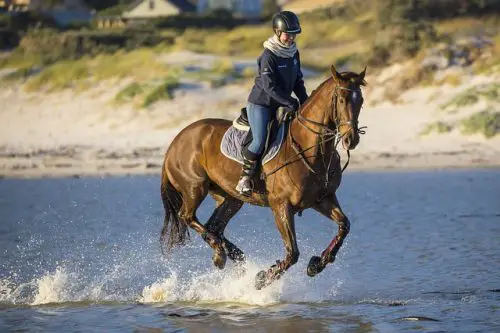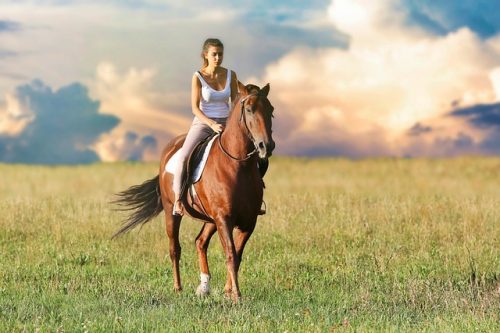Horse riding is a very recreational and healthy activity carried out by all ages. Despite the fun, most people still wonder if consistent horse riding is bad for your back in the long run. This article tries to enlighten us on the possible effects and how to avoid or reduce them.
It is difficult to answer YES or NO to the question posed above. This is because the effects of horse riding on a back is mixed. So there are no definitive answers to these many questions. Let’s take a look at these two sides.
Horse Riding And Your Back
Being a sport in which the spine is often subject to high impact, studies have shown that 50% of horse riders are most likely to experience pain. Categorically, riders that take part in show jumping competitions had over two times the possibility of experiencing chronic pain that was long term compared to experiencing acute pain that was short term.

In cases where the riders get to experience pain, 85% of them reported it to be in the neck and back, with back pain posing as the major. 66% made a report of having pains in other areas of the body. 85% of the riders who came down with pain reported that their general riding performance was impacted by the pain.
As a result, their range of motion gets reduced, more to it, their postural symmetry gets affected.
Advantages Of Horse Riding To The Back
The characteristic advantage of riding a horse is the relationship that would spur between the horse rider and the horse. Therefore, if you hope on becoming a successful rider, then there is a need for you to team up with your horse and work together for that greater benefit.
Teaming up with the horse would entail that as a rider, there is a dire need for you to adapt to the rhythm of the horse’s movements. Via this channel, you would observe that your movement together with that of the horse would be regular and fluent as opposed to the sudden and jerky movement that happens if there is no relationship between you as the horse rider and the horse.
As a result, the regular intervals in which you get tensed up would be reduced. This will helps to ease the tension experienced by the muscle and subsequently relieve the pain.
Your posture when sitting on the horse also matters because if you sit in a relaxed and upright way, you actually train and stabilize your stomach and back muscles. This practice is considered very important because not only does it let you train a single part of muscle but importantly the respective components.
It is also a notable prerequisite in sports of any kind where the athlete involved is up for effective but gentle training of the muscle.
More to the above-mentioned advantages of horse riding is the improvement of your own coordination, your motor skills, and your balance because as a rider, regular training additionally improves your physical endurance and positively affects the circulatory system[1].
 .
.
Disadvantages Of Horse Riding
On the other side of the coin is the dangerous aspect of riding a horse, such that can surface if the rider already had back problems before setting off to become a horse rider.
More often than not, the pain that riders suffer usually occurs during or directly after the ride. This is mostly caused by the wrong posture of the body during the ride because muscles tend to experience tension and campiness.
Riders who are beginners are often affected because they tend to be timid and as a result stiffen their pelvis, shoulder, back, and neck because they are scared. With this, there will be an advancement in any form of light back pain they may have previously suffered from or was enduring.
The entire scenario will eventually cause all muscles to become tensed and cramped later resulting in pain.
The riding style that affects the back the most is galloping because the vertebral column constantly gets subjected to lots of stress. This happens irrespective of the fact that the muscles of the upper leg and the muscles of the lower legs can take up the vibrations that arise when riding, as a form of compensation.
Ways To Prevent Possible Back Pain While Riding
Some people will experience back pain while riding horses. This can be caused by a variety of factors including the type of saddle, incorrect posture, or even poor weight distribution.
It is important to note that many riders may not have any discomfort at all and this could simply be due to an individual’s body structure or fitness level. The most common types of back pain are muscle spasms in the lower back area because they often occur when we sit for long periods of time without moving around much.

Maintain Proper Posture
As a horse rider, you should be very keen about maintaining proper posture while riding as this will help make your back muscle relaxed. However, you must note and understand the natural shape of your spine.
Always be observant and proactive because certain scenarios would arise from time to time, scenarios that are likely to affect your posture. Note that if you are proactive and observant, you would be able to identify and counteract these scenarios.
For instance, as a horse rider stretches should compulsorily be incorporated into your schedule as they would help prevent you from developing tight hip flexors as well as rounded upper back. These regular stretches will help keep back pain at bay as it would prevent certain strains and stress that the muscles would have been subjected to.
Strengthen Your Muscles and Core
Naturally, the design of your spine includes curves and these curves are there to ensure that your spine balances perfectly. As you ride a horse, the motion that erupts is usually absorbed by the vertebra discs.
The central part of your body is your core. All the muscles that work to support your torso are your core. The ability of your spine to move correctly and also the position too can be affected by any tightness or weakness you may experience. However, this tightness or weakness, if disregarded, could gradually become stress which is likely to cause pain.
To maintain stability when riding a horse, lots of movement is required from your body. With each stride the horse makes your bodyweight gets to float up and back due to the many movements your hip bone makes. The hip bone which is part of the pelvis moves up and down, in and out, as well as forward and backward.
However, when this movement is hampered in the pelvis area, the hip bone is forced to head straight to the back.
Glossary
- Health Is Best [Link]

